
Organic reaction mechanisms - 1998
.pdf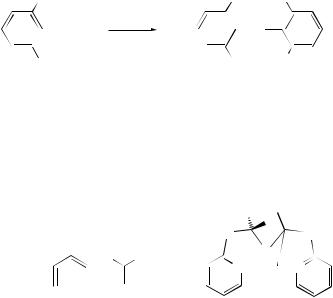

354 |
Organic Reaction Mechanisms 1998 |
A further study of the aggregation state of PhLi in etheral solvents has resolved signals for the ipso carbon which firmly establish the tetramer and dimer structures in diethylether, and the dimer and monomer structures in THF.16 The effects of polar additives such as THF, DME, dioxolane, 2,5-dimethyltetrahydrofuran, TMEDA, PMDTA, HMTTA, HMPA, DMPU, and 12-crown-6 to solutions of PhLi in diethylether and/or THF have been studied by low-temperature multinuclear techniques.
1,2- versus 1,4-regioselectivity of lithiated phenylacetonitrile towards α,β- unsaturated carbonyl compounds has been interpreted in terms of monomer–dimer equilibria (dependent on solvent dielectric constant) between ion pairs in solution.17,42 The lithiated monomer is believed to have a lithium bridged structure, as evidenced by IR and 13C NMR and supported by ab initio calculations.17
The crystal and solution structures of a range of N -lithio-α-aminonitrile anions have been characterized and the effects of association on the transition state for 1,4-addition of enantiopure lithiated α-aminonitriles to Michael acceptors have been discussed.18
Aromatic and Other Delocalized Anions
NMR study of tribenzylidenemethane dianion (21) (and its derivative having m,m - dimethyl substitution on one ring) has established that the benzylic positions are ca sp2.5 hybridized and that only ca 50% of the net charge (2−) remains on the Y- frame carbons.19 Thus, the benzylic bonds have gained double bond character due to p –π conjugation and charge delocalization on to the rings. Rotation about the Y-bonds is fast on the NMR time-scale and it has been reasoned that the Y-bonds are weaker than the benzylic bonds; this is therefore inconsistent with a through-the-center delocalization of Y-shaped dianions. Minimization of electrostatic repulsions between the three lone pairs by distribution of the extra charge to the ’corners’ seems to be the origin of the remarkable stability of trimethylenemethane dianion and its derivatives.
2−
H |
|
|
|
|
H |
|
|
|
|
H |
|
|
|
|
|
|
|
|
|
|
|
||||||
|
|
|
|
|
|
|
|
|
|
|
|
||
H |
|
• |
|
|
|
|
− |
|
|
||||
|
|
CH2 |
|
|
• • |
|
CH2 |
||||||
|
|
|
|
H2C |
|
• |
|
H2C |
|
• |
|
||
|
|
|
|
|
|
|
|
||||||
|
|
|
|
|
|
|
|
||||||
H |
|
|
|
|
|
|
|
|
|
||||
(21) |
|
|
|
|
|
H |
|
|
|
|
H |
|
|
|
|
|
|
|
|
|
|
|
|||||
|
|
|
|
(22) |
|
|
|
(23) |
|
|
|||
|
|
|
|
|
|
|
|
|
|||||
|
|
|
|
|
|
|
|
|
|||||
The solid aromatic dianion salt of 1,2-di-[13C][8]annulene has not been found to scramble the 13Cs even on heating to over 600 ◦C for 2 hs.20 This behaviour of the cyclooctatetraene dianion is in contrast with that of neutral aromatic systems, which readily automerize in the gas phase. Apparently, when sufficient energy is applied
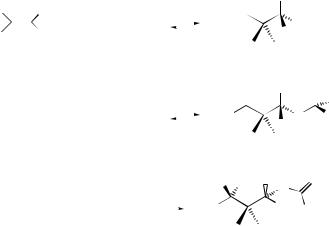
11 Carbanions and Electrophilic Aliphatic Substitution |
355 |
to overcome the lattice energy of the dianion, the expected carbene intermediate is formed but the larger electron–electron repulsion energy of the contracted ring induces electron transfer back to the metal.
The non-Kekule´-benzene negative ion (23), generated in the gas phase, has been found to display characteristic radicaland carbanion-type reactivity including adduct formation with NO, COS, and CO2, S-atom abstraction from CS2, and thiomethyl group abstraction from CH3SSCH3.21 Results of density functional calculations of the structures and energies of (23) and the corresponding biradical (22) carried out at the B3LYP/6–31+G level are in good agreement with results of experimental and theoretical thermochemistry.
Carbanion Reactions
Enolates and Related Species
Catalysed enantioselective aldol additions of latent enolate equivalents have been reviewed22 and electronic effects of the aldehyde component on such reactions of trichlorosilylenolates of cyclopentanone and cycloheptanone, catalysed by chiral phosphoramides, have been interpreted23 in terms of initial aldehyde coordination to the trichlorosilyl enolate and aldolization via a six-membered boat-like transition state.
The mechanism of the aldol–Tishchenko reaction has been probed by determination of kinetics and isotope effects for formation of diol–monoester on reaction between the lithium enolate of p-(phenylsulfonyl)isobutyrophenone (LiSIBP) and two molecules of benzaldehyde.24. The results are consistent with the formation of an initial lithium aldolate (25) followed by reaction with a second aldehyde to form an acetal (26), and finally a rate-limiting intramolecular hydride transfer (Tishchenko
|
|
|
|
|
|
|
|
|
O |
|
OLi |
|
|
|||
LiO |
|
Me |
|
|
|
|
k1 |
|
|
|
|
|
|
(1) |
||
|
|
+ |
R′CHO |
|
|
|
|
|
|
|
R′ |
|
||||
|
|
|
|
|
|
|
R |
|
|
|
|
|||||
|
|
|
|
|
|
|
|
|
|
|||||||
R |
|
Me |
|
|
|
|
k−1 |
|
Ha |
|
|
|||||
|
(24) |
|
|
|
|
|
|
|
|
|
|
(25) |
|
|
|
|
|
|
|
|
|
|
|
|
|
O |
|
R′ |
|
OLi |
|
||
|
(25) + |
R′CHO |
|
|
|
k2 |
|
|
|
|
R′ |
(2) |
||||
|
|
|
|
|
|
|
|
|
||||||||
|
|
|
|
|
|
R |
|
Ha |
O |
Hb |
|
|||||
|
|
|
|
|
|
|
|
|||||||||
|
|
|
|
|
|
|
|
|||||||||
|
|
|
|
|
|
|
k−2 |
|
|
|
|
|||||
|
|
|
|
|
|
|
|
|
|
|
|
(26) |
|
|
|
|
|
|
|
|
|
|
|
|
|
LiO Hb |
Ha |
O |
|
O |
|
||
|
|
|
|
|
|
|
|
|
|
|
|
|
|
|
(3) |
|
|
|
|
(26) |
k3 |
|
|
|
R |
|
R′ |
|
|
||||
|
|
|
|
|
|
|
R′ |
|
||||||||
|
|
|
|
|
|
|
|
|
|
|||||||
|
|
|
|
|
|
|
|
|
|
|
|
|
|
|
||
(27)
SCHEME 1

356 |
Organic Reaction Mechanisms 1998 |
reaction). Theoretical kinetic and equilibrium isotope effects, based on ab initio molecular orbital calculations, are in agreement with those determined experimentally using benzaldehyde-d, for which KIEob = 2.0 reflects both the true KIE of eq. 3 and the equilibrium isotope effect of eq. 1 and 2.
Darzens reaction of (−)-8-phenylmethyl α-chloroacetate (and α-bromoacetate) with various ketones (Scheme 2) yields cis-glycidic esters (28) with high geometric and diastereofacial selectivity which can be explained in terms of both open-chain or non-chelated antiperiplanar transition state models for the initial aldol-type reaction; the ketone approaches the Si-face of the Z-enolate such that the phenyl ring of the chiral auxiliary and the enolate portion are face-to-face.25 Aza-Darzens condensation reaction of N -benzylideneaniline has also been studied. Kinetically controlled basepromoted lithiation of 3,3-diphenylpropiomesitylene results in E : Z enolate ratios in the range 94:6 (lithium diisopropylamide) to 50:50 (BuLi), depending on the choice of solvent and temperature.26
R3 |
|
|
R4 |
ButOK |
R3 |
O R1 |
XCR1HCO2R2 + |
|
|
|
|||
|
|
|
CH2Cl2 |
R4 |
CO2R2 |
|
|
O |
|||||
|
|
|
|
−78 O °C |
|
(28) |
|
|
|
|
|
|
|
SCHEME 2
The mechanism of reaction between barbiturate and 1,3-dimethylbarbiturate ions with o-nitro-, p-nitro-, and 2,4-dinitrobenzaldehyde has been explored;27 rate dependence on solvent viscosity is indicative of involvement of a diffusion-controlled proton transfer in the rate-determining step at pH 2–4. Unexpected values of Brønsted α for the acid-catalysed process have been explained.
The relative reactivities of the enolate ions of acetophenone and 2-acetylnaphthalene towards phenyl radicals have been explored in order to determine their suitability as electron donor initiatiors of SRN1 reactions of enolate ions of 2-acetylthiophene and 2-acetylfuran with aryl halides PhI.28
A chair-like amino–zinc–enolate transition state has been used to explain how substituents on the ring affect the diastereoselective and enantioselective formation of polysubstituted pyrrolidines during intramolecular amino–zinc–enolate carbometallation reactions.29
Products of ethylation and methylation of enolates of cycloalkane-1,3-diones with ring sizes 7–10 have been studied under a variety of alkylating reagent–solvent systems.30 Decrease in the O/C alkylation ratios with increase in ring size is believed to be a consequence of greater steric strain in the conjugated enolate resonance contributor and consequent diminution in the proportion of O-attack.
Fluorination of the sodium enolate of 2-methyl-1-tetralone by (−)-N -fluoro-2,10- (3,3-dichlorocamphorsultam) gives (S)-(+)-2-fluoro-2-methyl-1-tetralone in 70% ee, which corresponds to the opposite asymmetric induction to that achieved using nonracemic (camphorsulfonyl)oxaziridines as closely related hydroxylation reagents.31

11 Carbanions and Electrophilic Aliphatic Substitution |
357 |
The mechanism of nitrosation of MeCOCH2−Na+ with MeONO to give MeCOCH=NOH has been studied by HF and MP3 ab initio methods;32 pericyclic rearrangement of first-formed adduct gives an intermediate complex, [MeCOCH2NO(OMe)]− Na+, from which the product is obtained by antiperiplanar elimination of MeOH.
It has been shown that a complete shift in stereochemistry of the nucleophilic reactions of (29), with alkyl halides such as 2-bromobutane or cis-2- bromomethoxycyclohexane, from racemization to complete inversion, is induced by increase in the inner-sphere stabilization of the transition state from 0 to 3 kcal mol−1.33 This has been ascribed to competition between inner-sphere SN2 and outer-sphere electron-transfer processes; the former being extremely sensitive towards inner-sphere stabilization.
CO2Me |
|
|
Ar |
|
|
|
|
|
|
Ar |
|||||
− |
O |
|
O |
||||||||||||
|
|
|
|
|
|
O |
LDA/THF |
Bn |
|
|
|
|
|
O |
|
|
|
|
|
|
|
|
|
||||||||
|
|
|
|
|
|
BnBr |
|
|
|
|
|
|
|||
N |
NHCPh |
H |
|||||||||||||
|
|||||||||||||||
|
NHCPh |
||||||||||||||
|
|
|
|
|
|
|
|
|
|
|
|
|
|
|
|
Me |
O |
|
|
|
|
|
O |
||||||||
(29) |
|
|
(30) |
|
(31) |
||||||||||
A further attempt has been made to develop a predictive model for chirality transfer achieved through alkylation reactions of ester enolates which feature chiral auxiliaries.34 Hippurate esters (30) derived from (1R ,2S )-trans-2-(p-substituted phenyl)cyclohexanols were found, on reaction with benzyl bromide, to give (31) with predominantly the S configuration at the alkylation centre but with no correlation between the degree of stereoselectivity (20–98%) and the electron density on the aromatic ring.
Diastereoselectivity in the aldol and the conjugate additions of 2 -hydroxy-1,1 - binaphthyl ester enolates with a variety of carbonyl electrophiles has also been explored;185 the tendency of the ester enolates, generated by BuLi, to react with aldehydes to give threo products preferentially with high diastereoselectivity has been interpreted in terms of an acyclic transition state of chelated lithium enolate involving the aldehyde carbonyl and the 2 -hydroxy group.
Nucleophilic addition of ester-derived enolate to the bicyclo[3.3.0]octan-2-one system of diacetone glucos-3-ulose usually occurs at the convex β-face of the carbonyl (as for other nucleophiles), except for senecioate-derived enolate (from 3-methyl crotonate) for which α-attack in diethylether solvent is in contrast to the β-face attack in THF;36 the reason for this anomalous behaviour is not clear.
The Baylis–Hillman reaction (Scheme 3) of ethyl vinyl ketone with electrondeficient aromatic aldehydes (e.g. where R1 = o-NO2C6H4), in MeCN or EtCN solution, has been found to proceed enantioselectively in presence of catalytic base (32) derived from proline.37 The Michael adduct formed between the catalyst and the vinyl
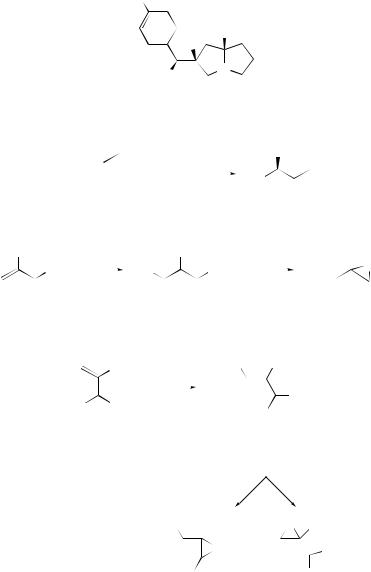
358 |
|
|
|
|
|
|
|
|
|
|
|
Organic Reaction Mechanisms 1998 |
|||||||||||
|
|
|
|
|
|
O2N |
|
|
|
|
|
|
|
|
|
|
|
|
|
|
|
||
|
|
|
|
|
|
|
|
|
|
H |
H |
|
|
|
|
|
|
|
|
|
|
||
|
|
|
|
|
|
|
|
|
|
N |
|
|
|
|
|
|
|
|
|
|
|||
|
|
|
|
|
|
|
|
|
|
|
|
|
|
|
|
|
|
|
|
||||
|
|
|
|
|
|
|
|
|
OH |
|
|
|
|
|
|
|
|
|
|
||||
|
|
|
|
|
|
|
|
|
|
|
|
|
|
|
|
|
|
|
|
|
|||
|
|
|
|
|
|
|
|
|
(32) |
|
|
|
|
|
|
|
|
|
|
|
|
||
|
|
|
|
O |
|
|
|
|
|
|
|
|
|
|
|
|
|
|
|
||||
|
|
|
|
|
|
R2 |
|
10 mol% |
|
|
|
OH |
O |
|
|
||||||||
|
|
|
|
|
|
|
|
|
|
|
|||||||||||||
R1CHO + |
|
|
|
(32) |
|
|
R |
1 |
|
|
|
|
R |
2 |
|
||||||||
|
|
|
|
|
|
|
|
||||||||||||||||
|
|
|
|
|
|
|
|
|
|
|
|
|
|
|
|||||||||
NaBF4, MeCN |
|
|
|||||||||||||||||||||
|
|
|
|
|
|
|
|
|
|
|
|
|
|
|
|
||||||||
|
|
|
|
|
|
|
|
|
|
−40 °C |
|
|
|
|
|
|
|
|
|
|
|||
|
|
|
|
|
|
|
|
|
SCHEME 3 |
|
|
|
|
|
|
|
|
|
|
||||
CO2Et |
|
Nu− |
|
CO2Et |
|
|
|
−ButO− |
|
|
|
CO2Et |
|||||||||||
OOBut |
|
|
− |
OOBut |
|
|
|
|
O |
||||||||||||||
|
|
|
|
|
Nu |
|
|
|
|
|
|
|
Nu |
|
|||||||||
|
|
|
|
|
|
|
|
|
|
|
|
|
|||||||||||
[Nu− = −CH(CO2R)2] |
|
|
|
|
|
|
|
|
|
|
|
|
|
|
|
||||||||
|
|
|
|
|
|
|
|
|
SCHEME 4 |
|
|
|
|
|
|
|
|
|
|
||||
|
|
|
|
CO2Et |
|
|
|
ButOO |
|
|
|
CO2Et |
|
|
|
|
|||||||
|
|
|
|
|
|
|
|
|
|
|
− |
|
|
|
|
||||||||
ButOO− + |
|
|
|
|
|
|
|
|
|
|
|
|
|
|
|
|
|
|
|
||||
|
|
|
|
|
|
|
|
|
|
|
|
|
|
|
|
|
OOBut |
|
|
||||
|
|
|
OOBut |
|
|
|
|
|
|
|
|
|
|
|
|||||||||
Me |
|
|
|
|
|
|
|
|
|
|
|
|
|
|
|||||||||
|
|
|
|
|
|
|
|
Me |
|
|
|
|
|||||||||||
|
|
|
|
|
|
|
|
|
|
|
|
|
|
|
|
|
|
||||||
|
(33) |
|
|
|
|
|
|
|
|
|
(34) |
|
|
|
|
|
|
||||||
|
|
|
|
|
|
|
|
|
|
|
|
|
|
|
|
|
−ButO− |
|
|
|
|
||
|
|
|
|
|
|
|
|
|
|
|
|
|
|
|
|
|
|
|
|
|
|||
|
|
|
|
|
|
ButOO |
CO2Et |
|
|
|
O |
|
CO2Et |
|
|||||||||
|
|
|
|
|
|
|
|
|
|
|
|
O |
|
|
|
|
|
|
|
OOBut |
|||
|
|
|
|
|
|
|
|
|
|
Me |
(14%) |
|
|
|
|
|
Me |
|
(12%) |
||||
|
|
|
|
|
|
|
|
|
(35) |
|
|
|
|
|
|
|
|
(36) |
|
|
|||
ester is believed to be directed in its nucleophilic attack on the aldehyde as a consequence of metal ion bridging between the aldehyde carbonyl group and the 2 -hydroxyl group of the catalyst.
A study of the anion-induced decomposition of 2-ethoxycarbonyl prop-2-enyl peroxides has established that epoxides so formed arise (Scheme 4) through (i) addition of the nucleophile to the acrylic unsaturated bond and (ii) intramolecular anionic

11 Carbanions and Electrophilic Aliphatic Substitution |
359 |
substitution on the peroxidic bond.38 The formation of two peroxy epoxides, (35) and (36), on addition of But OOK to peroxide (33) is consistent with competing SNi reactions of a carbanion intermediate (34) in this two-step process.
Potassium enolates derived from the chiral Schiff bases obtained by reaction of racemic α-amino esters with 2-hydroxypinan-3-one undergo diastereoselective protonation, as evidenced by release of optically active α-amino esters on subsequent cleavage of the imine (Scheme 5).39
OH |
|
|
OH |
|
N |
CO2Me |
N |
CO2Me |
|
|
|
(i) ButOK, THF |
|
|
R |
|
(ii) NH4Cl |
|
R |
|
|
|
|
B(OH)3 |
|
|
|
|
|
|
|
|
|
|
H2N  CO2Me
CO2Me
R
SCHEME 5
Nucleophilic addition of phenolic nucleophiles to 1,1-dicyano-2-arylethenes in the gas phase and in water has been studied theoretically40 using the semiempirical AM1 method and the Cramer–Truhlar solvation model SM2.1. The difference between the Brønsted coefficients (αn = 0.81 and βn = 0.65) determined for the gas-phase reaction is indicative of a small positive transition state imbalance of I = 0.16. For reaction in water the estimates (αn = 0.61 and βn = 0.36, giving I = 0.25) are close to the experimental values (αn = 0.55 and βn = 0.35) obtained with amine bases, and the small imbalance is as expected for a reaction involving no hybridization change at the incipient carbanion site.
The fluorenide anion (37), which is thermodynamically much less stable than its isomer (38), 9-fluorenylmalononitrile carbanion, has been generated for the first time by a hydride transfer from 1-benzyl-1,4-dihydronicotinamide to (39), in dry acetonitrile; quenching of (37) with CH3CO2D gave 9-d-fluorenylmalononitrile (40). 41 Furthermore, salt (41) gave (42) and (44) on prolonged heating at 60 ◦C.
Benzylideneacetone reacts with lithiated phenylacetonitrile under kinetic control, in THF and media that favour association, to give 1,2- and 1,4-adducts in proportions which are directly related to concentrations of monomeric and dimeric ion pair species, respectively.42 An attempt has been made to explain the different regioselectivities towards α,β-unsaturated carbonyl compounds, including cyclic α-enones and cinnamaldehyde, in terms of intermediate complex formation.
Results of an investigation of the structure of lithiated α-aminonitriles have been used to aid interpretation of the diastereofacial preference found for reaction of their chiral counterparts with Michael acceptors.18
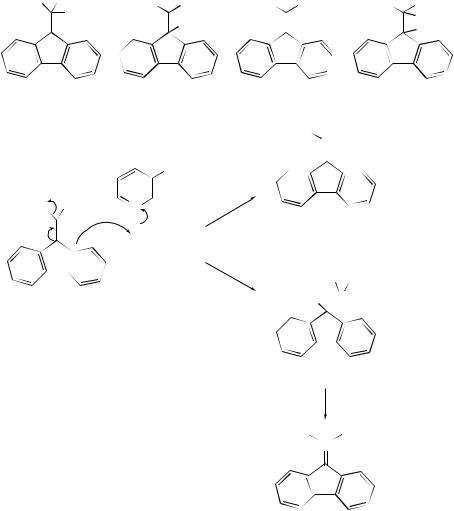
360 |
|
|
|
|
Organic Reaction Mechanisms 1998 |
||||
NC |
CN |
NC |
− |
CN |
NC |
|
CN |
NC |
CN |
|
H |
|
|||||||
|
|
|
H |
|
|
|
|
H |
|
|
|
|
|
|
|
|
|
||
|
− |
|
|
|
|
|
|
D |
|
|
|
|
|
|
|
|
|
||
(37) |
|
|
|
(38) |
|
(39) |
|
|
(40) |
||
|
|
|
|
|
|
|
H |
CN |
|||
|
|
|
|
|
|
|
C |
|
|
||
|
a |
|
|
|
CONH2 |
a |
|
|
|
|
|
|
|
|
|
|
|
|
|
|
|||
|
|
|
|
|
|
|
|
|
|
||
|
|
|
|
|
|
|
|
|
|
||
NC |
CN |
b |
+ N |
b |
|
|
|
|
|
||
H |
|
(42) |
|
|
|||||||
a |
|
|
|
|
|
||||||
|
|
|
|
|
|
|
|||||
− |
|
CH2Ph |
|
|
|
|
|
|
|||
|
|
|
|
|
|
|
|
||||
|
|
|
|
|
|
b |
|
|
H |
H |
|
|
|
|
|
|
|
|
|
|
|
|
|
|
|
(41) |
|
|
|
|
(CN)2CH C |
|
Ph |
||
|
|
|
|
|
|
|
|||||
|
|
|
|
|
|
|
|
|
|
|
|
(43)
−CH2(CN)2
H Ph
C
(44)
Reactions of nitrobenzenes with tertiary carbanions, generated from α-substituted phenylacetonitriles (45) in liquid ammonia, to give competing products of oxidative nucleophilic substitution of hydrogen (ONSH) or vicarious nucleophilic substitution (VNS) have been found to depend strongly on the nature of the leaving group on the carbanion.43 Carbanions from (45a) and (45b) react with PhNO2 predominantly to form the ONSH product (48); in contrast, 2-chloropropionitrile fails to react with PhNO2, or even the very electrophilic 3,5-difluoronitrobenzene, via an oxidative pathway in absence of KMnO4 but forms a moderate yield of VNS products (49) and (50).
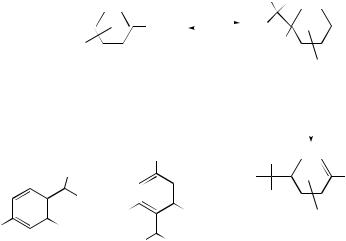
11 Carbanions and Electrophilic Aliphatic Substitution |
|
|
361 |
|||||||||||||||
|
|
|
|
|
|
|
|
NaNH2 |
Ph CN |
|
|
|
|
|
||||
PhCH(R)CN + |
|
|
|
NO2 |
|
lig. NH3 |
|
|
|
|
|
|
NO2− |
|||||
|
|
|
R |
|
|
|
|
|||||||||||
|
|
|
|
|
|
|
|
|
|
|
|
|||||||
|
|
|
|
|
|
|
|
|
|
|
|
|||||||
|
|
|
|
−70 |
°C |
|
|
|
|
|||||||||
|
|
X |
|
|
|
|
|
H |
|
|
|
|
|
|
||||
|
|
|
|
|
|
|
|
|
|
|
|
|
|
|
|
|
||
(45) |
|
(46) |
|
|
|
|
|
|
|
|
|
|
X |
|||||
a; R = MeO |
|
|
|
|
|
|
|
|
|
|
(47) |
|
|
|||||
b; R = PhO |
|
|
|
|
|
|
|
|
|
|
2 min |
|
KMnO4 |
|||||
|
|
|
|
|
|
|
|
|
|
|
||||||||
c; R = Me |
|
|
|
|
|
|
|
|
|
|
|
|||||||
|
|
|
|
|
|
|
|
|
|
then NH4Cl |
|
|||||||
NO2 |
Me |
NO2 |
|
|
|
|
|
CN |
|
|
|
|
|
|||||
|
|
|
|
|
|
Ph |
|
|
|
|
|
|
NO2 |
|||||
|
|
|
|
|
|
|
|
|
|
|
|
|
|
|
|
|
||
|
|
CN |
|
|
|
|
|
|
|
R |
|
|
|
|
|
|
||
|
|
|
|
|
|
|
|
|
|
|
|
|
|
|
||||
|
|
|
F |
|
|
F |
|
|
|
|
|
|
X |
|||||
|
|
|
|
|
|
|
|
|
|
|||||||||
F |
F |
|
|
|
|
|
|
|
(48) |
|
|
|||||||
|
|
|
|
CN |
Me |
|
|
|
|
|
|
|
||||||
|
|
|
|
|
|
|
|
|
(ONSH product) |
|||||||||
(49) |
|
|
|
(50) |
|
|
|
|
|
|
||||||||
|
|
|
|
|
|
|
|
|
|
|
|
|
|
|
|
|||
The ONSH reaction of the carbanion of 2-phenylpropionitrile (45 c) with nitrobenzene in liquid ammonia at −70 ◦C involves rate-limiting Carom−H bond breaking, as evidenced by the 9.8 times faster rate than for reaction of the analogous substitution of deuterium in 4-d-nitrobenzene and perdeuterionitrobenzene.44 Reactions of the carbanion derived from (45c) with 4-chloro-3-trifluoromethylnitrobenzene and 4-chloronitrobenzene in toluene under phase transfer catalysis has also been studied.45
Novel episulfone substitution and ring-opening reactions via α-sulfonyl carbanion intermediates have been reviewed.46
Kinetic, thermodynamic and NMR approaches have been applied in a study of the ionization of benzyltriflones in Me2SO and H2O–Me2SO mixtures.47 The high intrinsic Marcus reactivities for deprotonation of (51a–e) and the enhancement of acidity (in contrast to the effect on acidity of arylnitromethanes) on going from hydroxylic solvents to Me2SO indicate that, in solution, the anionic charge [at least for unsubstituted (51a)] resides predominantly on Cα ; stabilization by the SO2CF3 group is a consequence of polarization effects rather than of conjugative d –p π -bonding or negative hyperconjugation. This is not in agreement with earlier crystal structures or with results of high level ab initio gas-phase studies.
Hydrolysis of 2,2,2-trifluoroethanesulfonyl chloride has been found to proceed via intermediate sulfene (CF3CH=SO2) formed by E1cB reaction.48 At pH 1.8–5.0 the (E1cB)irr mechanism applies, whereby water and hydroxide ion act, respectively, as the carbanion-forming base at low and high pH extremes. The (E1cB)rev reaction applies in dilute acid and is accompanied by the expected H–D exchange of substrate protons when D2O is used as solvent.
Hammett correlations of effects of substituents (R) on dehydrochlorination of 2-chloroethylsulfones p-RC6H4SO2CH2CH2Cl and p-RC6H4SO2CH2CHClPh with
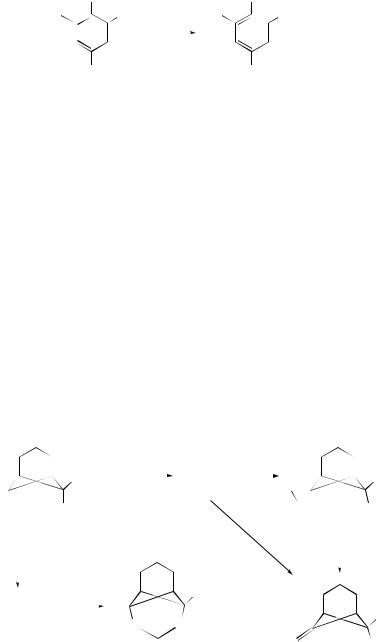
362 |
|
|
|
Organic Reaction Mechanisms 1998 |
||
|
CH2SO2CF3 |
|
|
−CHSO2CF3 |
||
R6 |
|
R2 |
|
R6 |
|
R2 |
|
|
|
base |
|
|
|
|
|
|
|
|
||
|
|
|
|
|
|
|
|
R4 |
|
|
R4 |
||
|
(51) |
|
|
|
(52) |
|
a; R2 = R4 = R6 = H |
|
|
|
|
||
b; R2 = R6 = H, R4 = CN c; R2 = R6 = H, R4 = NO2 d; R2 = R4 = NO2, R6 = H e; R2 = R4 = R6 = NO2
Et3N suggest that both reactions proceed via carbanion formation, to give the corresponding aryl vinyl and aryl styryl sulfones, respectively.49
α-Sulfonyl carbanion intermediates have been proposed to account for the series of transformations of 6-halomethylsulfonyl-substituted bicyclic[3.1.1]heptanes (53) depicted in Scheme 6.50
Dimethylcarbonate, in presence of K2CO3, has been found to react with benzyl aryl and alkyl aryl sulfones RCH2SO2Ar at 180–210 ◦C to form the corresponding mono- C-methyl derivative selectively and in high yield.51 The monomethylation has been attributed to a methoxycarbonylation-methylation-demethoxycarbonylation sequence via ArSO2C(Me)(CO2Me)R.
Carbanions of chloromethyl aryl sulfone (Ar = Ph or p-tolyl) in DMSO–But OK react with 9,10-anthraquinone by vicarious nucleophilic substitution or addition to the
XCH2SO2 |
|
|
Ph |
|
MeONa/MeOH |
(53b) |
ButOK/THF |
|
Ph |
||
|
|
|
|
|
|
SO2 |
|
||||
|
|
|
Y |
|
|
|
OMe |
||||
|
(53a) |
|
NaOH |
(54) |
|||||||
|
|
Na2CO3 |
aq. dioxane |
|
∆ |
||||||
|
|
|
|||||||||
|
|
|
|
|
|
||||||
|
|
aq. THF |
Ph |
|
|
||||||
|
|
|
aq. dioxane |
|
|
||||||
|
|
|
|
|
|||||||
|
(53c) |
|
+ (55c) |
|
|
||||||
|
|
|
|
|
Ph |
||||||
|
NaOH |
|
|
||||||||
|
|
|
O |
|
|||||||
|
|
|
|
|
O2S |
|
|
||||
|
(56) |
|
|
|
|
Y |
|||||
|
|
|
|
(55b) |
|||||||
X = Br, a; Y = Br, b; Y = OMe, c; Y = OH
SCHEME 6

 Li
Li


 Li
Li
 Li
Li